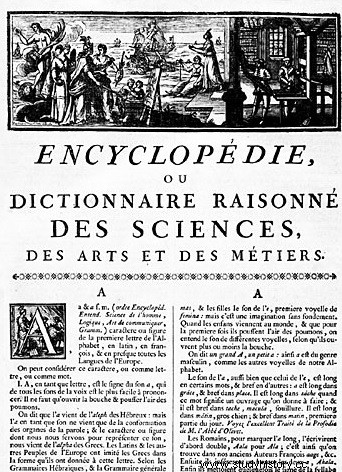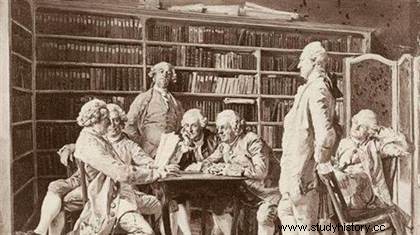 The Encyclopedia of Diderot and D'Alembert , composed of 28 volumes, was published between 1751 and 1772. The project of the Encyclopedia was originally to bring together the knowledge acquired by humanity and to promote the people's access to knowledge. Materialism and the fight against Christianity of Diderot are part of the foundations of the Encyclopedia, which will be worth the hostility of the Court and the Church. Many 18th century scientists and men of letters, such as Montesquieu, Voltaire or Rousseau, contributed to this work, which was to enjoy immense success in France and Europe, contributing to the propagation of the spirit of enlightenment.
The Encyclopedia of Diderot and D'Alembert , composed of 28 volumes, was published between 1751 and 1772. The project of the Encyclopedia was originally to bring together the knowledge acquired by humanity and to promote the people's access to knowledge. Materialism and the fight against Christianity of Diderot are part of the foundations of the Encyclopedia, which will be worth the hostility of the Court and the Church. Many 18th century scientists and men of letters, such as Montesquieu, Voltaire or Rousseau, contributed to this work, which was to enjoy immense success in France and Europe, contributing to the propagation of the spirit of enlightenment.
The Century of the Philosophers
In the 18th century, many French writers and thinkers began to call themselves "philosophers". Voltaire, Montesquieu or even Diderot then set themselves the objective of combating the darkness of ignorance by the dissemination of knowledge. Confident in the capacity of Man to determine himself by reason, the philosophers of the Enlightenment show an optimism towards History and believe in the progress of humanity.
 Among these philosophers is Denis Diderot, one of the boldest thinkers of his time. He embraced a literary career in 1743 by translating various English language works before publishing, three years later, his first book, entitled Philosophical Thoughts. Will follow Les Bijoux indiscrets (1748) and Letter on the blind for the use of those who see (1749) which earned him being locked up in the dungeon of Vincennes for three months. However, he is constantly looking for new profitable projects.
Among these philosophers is Denis Diderot, one of the boldest thinkers of his time. He embraced a literary career in 1743 by translating various English language works before publishing, three years later, his first book, entitled Philosophical Thoughts. Will follow Les Bijoux indiscrets (1748) and Letter on the blind for the use of those who see (1749) which earned him being locked up in the dungeon of Vincennes for three months. However, he is constantly looking for new profitable projects.
In 1745, the bookseller Le Breton decided to translate an illustrated dictionary of sciences and arts written by the Englishman Ephraim Chambers entitled the Cyclopedia and published in 1728. When he submitted his idea to Diderot, the latter proposes not a translation, but an original work, which would constitute a "general picture of the efforts of the human spirit in all genres and in all centuries". To embark on this adventure, he joins forces with one of his friends, the mathematician and philosopher Jean Le Rond d'Alembert, illegitimate son of the famous woman of letters, Madame de Tencin.
The beginnings of The Encyclopedia
In October 1750, Diderot set out his project in a Prospectus and managed to convince 2,000 subscribers. This success enabled him to carry out, with d'Alembert until 1759, a gigantic work, which would involve the greatest minds of the time. Among these, we must mention Voltaire, Montesquieu, Rousseau, Buffon, Helvétius, Condillac, d'Holbach, Daubenton, Marmontel, Quesnay, de Jaucourt, Grimm and Turgot. The first volume of the Encyclopedia or dictionary of reason ésciences, arts and crafts appeared on July 1, 1751.
 In the "Editors' Preliminary Speech d'Alembert explains to readers how the articles are structured and their philosophy. He also writes that the work “ has two objects:as an Encyclopedia, it must expose as much as possible, the order &the sequence of human knowledge; as a reasoned Dictionary of Sciences, Arts &Trades, it must contain on each Science &on each Art, whether liberal or mechanical, the general principles which are its base, &the most essential details, which make up its body &substance .
In the "Editors' Preliminary Speech d'Alembert explains to readers how the articles are structured and their philosophy. He also writes that the work “ has two objects:as an Encyclopedia, it must expose as much as possible, the order &the sequence of human knowledge; as a reasoned Dictionary of Sciences, Arts &Trades, it must contain on each Science &on each Art, whether liberal or mechanical, the general principles which are its base, &the most essential details, which make up its body &substance .
Years of hard work
The success of the Encyclopedia was immediate and the circulation increased significantly over the years. However, publication of each volume is not without difficulty. Not only did Diderot and D'Alembert have to order the articles from the authors, proofread them and correct them, which takes an insane amount of time, but they also have to face the attacks of the anti-philosophers, in the forefront of which are the devout party and the Jesuits. From 1752, the latter obtained a ban on selling, buying or possessing the first two volumes published, following a scandal caused by the thesis presented at the Sorbonne by one of the authors, the Abbé de Prades. Fortunately, the protection of Madame de Pompadour and that of the director of the bookstore, Malesherbes, allowed publishers to resume publication the following year.
In 1759, it was the deathblow. The Council of State again prohibits the sale of the Encyclopedia and orders the reimbursement of subscribers. Malesherbes intervenes but cannot prevent the publication ban. D'Alembert gives up and Diderot continues alone the work of preparing the last ten volumes, which are published clandestinely. Finally, in July 1765, the last of the seventeen volumes of texts appeared (the last volume of plates was published in 1772). In the end, 150 employees and 1,000 workers wrote 71,818 articles for 17 volumes of text. A real bestseller, this first edition of the Encyclopédie will bring in an estimated 2.5 million books.
The posterity of the Encyclopedia of Diderot and d'Alembert
 The company of Diderot and his collaborators allows the development of encyclopedic production. It also remains the symbol of the spirit of the Enlightenment. Attempts were still being made in Catholic circles, in the middle of the 19th century, to erase its traces with even more important monuments. Father Jacques-Paul Migne (1800-1875), founder of the Universal Library of the Clergy and publisher of the monumental collections of texts by the Fathers of the Church, Greek Patrology and Latin Patrology, thus brought out an Ecclesiastical Encyclopedia (1851-1859 ) in sixty-six volumes in order to relegate the "disastrous" Encyclopédie of Diderot and d'Alembert to being only "a pygmy of science and utility".
The company of Diderot and his collaborators allows the development of encyclopedic production. It also remains the symbol of the spirit of the Enlightenment. Attempts were still being made in Catholic circles, in the middle of the 19th century, to erase its traces with even more important monuments. Father Jacques-Paul Migne (1800-1875), founder of the Universal Library of the Clergy and publisher of the monumental collections of texts by the Fathers of the Church, Greek Patrology and Latin Patrology, thus brought out an Ecclesiastical Encyclopedia (1851-1859 ) in sixty-six volumes in order to relegate the "disastrous" Encyclopédie of Diderot and d'Alembert to being only "a pygmy of science and utility".
The posterity of Diderot's work also has another side:the Encyclopedia of Philosophical Sciences (1817), produced by the German philosophers Georg Wilhelm Friedrich Hegel and Johann Gottlieb Fichte , heirs to the philosophy of the Enlightenment and the French Revolution. Synthesis of knowledge as much as philosophical knowledge, Diderot's Encyclopedia, polemical mystification, catalog or Great Work, remains a unique work.
To go further
- Diderot and The Encyclopedia, by Jacques Proust. Albin Michel, October 1995.
- The encyclopedia of Diderot and d'Alembert and the encyclopaedist projects of the 18th century. Editions L'Harmattan, 2018.
- France during the Enlightenment 1715-1789, by Pierre-Yves Beaurepaire. Belin, October 2014.
